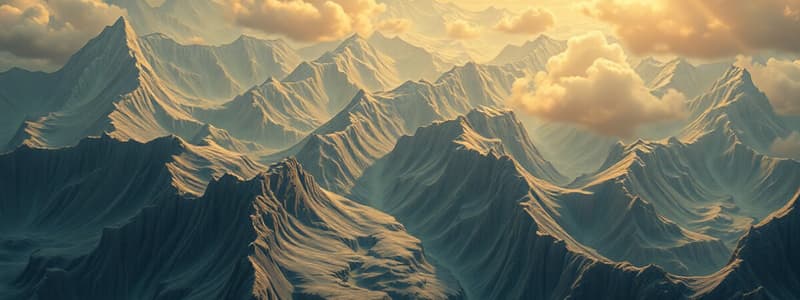Podcast
Questions and Answers
What causes the movement of tectonic plates?
What causes the movement of tectonic plates?
- Rotation of the Earth
- The gravitational pull of the moon
- Convection currents in the mantle (correct)
- The Earth's magnetic field
What primarily distinguishes continental and oceanic plates?
What primarily distinguishes continental and oceanic plates?
- Their location on Earth
- Their size and shape
- Their composition and density (correct)
- The presence of marine life
What geological feature results from the subduction of an oceanic plate beneath a continental plate?
What geological feature results from the subduction of an oceanic plate beneath a continental plate?
- Volcanic Mountain Range (correct)
- Strike-slip Fault
- Rift Valley
- Mid-ocean Ridge
What happens when an oceanic plate collides with a continental plate?
What happens when an oceanic plate collides with a continental plate?
Which landform is characteristic of a convergent boundary between two continental plates?
Which landform is characteristic of a convergent boundary between two continental plates?
Which landform is characteristic of a divergent plate boundary?
Which landform is characteristic of a divergent plate boundary?
What process causes the magma in the Earth's mantle to rise?
What process causes the magma in the Earth's mantle to rise?
What type of fault is typically associated with transform plate boundaries?
What type of fault is typically associated with transform plate boundaries?
What is the primary difference between convergent and divergent plate boundaries?
What is the primary difference between convergent and divergent plate boundaries?
What type of rock primarily makes up oceanic plates?
What type of rock primarily makes up oceanic plates?
Which geological feature is NOT typically associated with convergent plate boundaries?
Which geological feature is NOT typically associated with convergent plate boundaries?
What geological feature is formed when two oceanic plates converge?
What geological feature is formed when two oceanic plates converge?
What is an example of a landform created by a convergent boundary?
What is an example of a landform created by a convergent boundary?
What type of fault involves the upward movement of rock below a fault plane?
What type of fault involves the upward movement of rock below a fault plane?
What geological process leads to the formation of new crust at divergent plate boundaries?
What geological process leads to the formation of new crust at divergent plate boundaries?
Flashcards
Tectonic Plates
Tectonic Plates
Large slabs of Earth's lithosphere that move on the mantle
Convergent Boundary
Convergent Boundary
A boundary where two tectonic plates collide
Subduction
Subduction
When a denser plate sinks under another plate
Continental Plate
Continental Plate
Signup and view all the flashcards
Oceanic Plate
Oceanic Plate
Signup and view all the flashcards
Himalayas
Himalayas
Signup and view all the flashcards
Divergent Boundary
Divergent Boundary
Signup and view all the flashcards
Transform Boundary
Transform Boundary
Signup and view all the flashcards
Convergent boundaries
Convergent boundaries
Signup and view all the flashcards
Subduction zone
Subduction zone
Signup and view all the flashcards
Divergent boundaries
Divergent boundaries
Signup and view all the flashcards
Mid Atlantic Ridge
Mid Atlantic Ridge
Signup and view all the flashcards
Transform boundaries
Transform boundaries
Signup and view all the flashcards
San Andreas Fault
San Andreas Fault
Signup and view all the flashcards
Rift Valley
Rift Valley
Signup and view all the flashcards
Study Notes
Tectonic Plate Boundaries
- Tectonic plates are large sections of Earth's lithosphere (crust) that move on currents in the molten mantle.
- Two main types of plates: continental (lighter, less dense, granite) and oceanic (denser, heavier, basalt).
- Plate movement is driven by convection currents in the mantle: heated magma rises, cools, and sinks, creating currents.
Convergent Boundaries
- Two plates collide.
- Oceanic-Continental: Oceanic plate subducts (sinks) under the continental plate.
- Oceanic-Oceanic: One oceanic plate subducts under the other.
- Continental-Continental: Both plates push upward, forming mountain ranges.
- Examples: Himalayas (India and Eurasia colliding), Andes Mountains (subduction of oceanic plate under South American plate)
- Features: mountains, volcanoes, subduction zones, trenches, volcanic islands
Divergent Boundaries
- Two plates move apart.
- Magma rises to fill the gap, creating new crust.
- Oceanic: Mid-Atlantic Ridge (largest underwater mountain range).
- Continental: Rift valleys, such as the East African Rift Valley.
- Features: rift valleys, mid-ocean ridges, new crust formation
Transform Boundaries
- Two plates slide past each other horizontally.
- Friction builds, then releases energy as earthquakes.
- Fault lines are created (normal, reverse, strike-slip, oblique).
- Example: San Andreas Fault (Pacific and North American plates).
- Features: fault lines, earthquakes
Convergent vs. Divergent
- Convergent: Plates move towards each other, resulting in subduction or collision.
- Divergent: Plates move away from each other, resulting in spreading and new crust formation.
- Both can create mountains and volcanoes, but the processes differ.
- Summary table: Provided in the article.
Studying That Suits You
Use AI to generate personalized quizzes and flashcards to suit your learning preferences.




